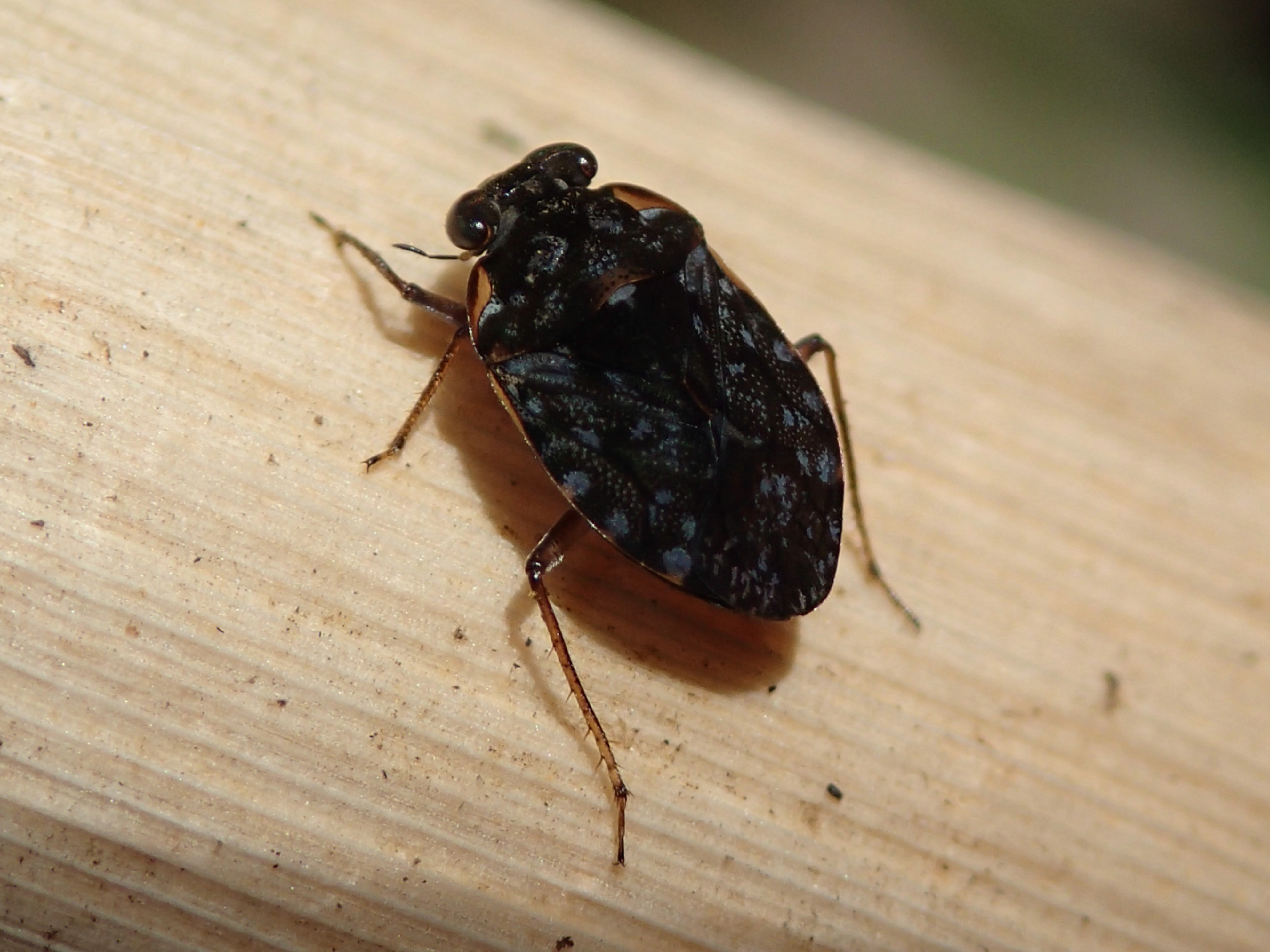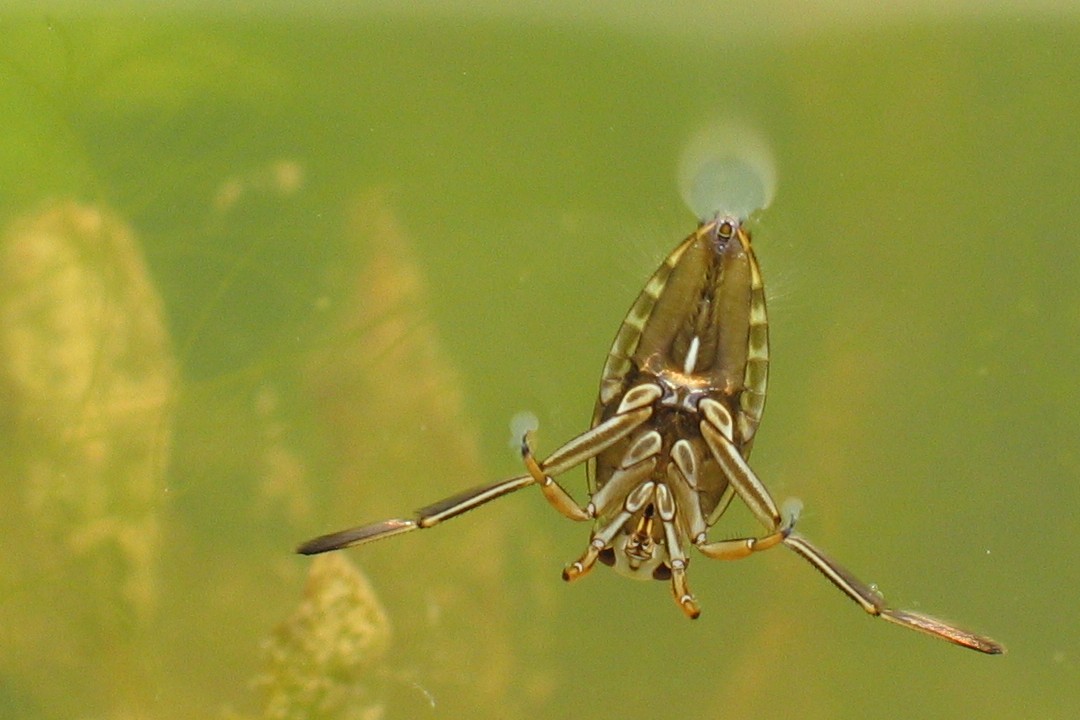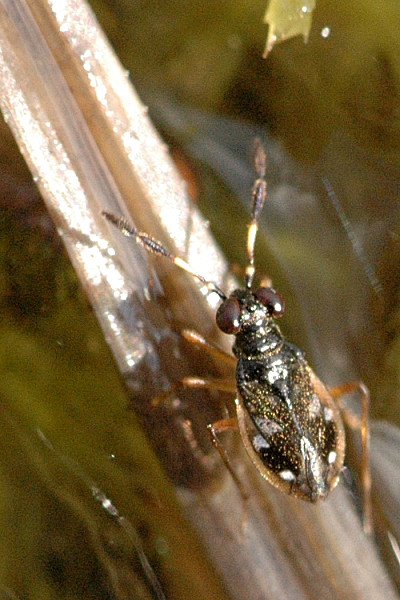|
Ochteridae
The Ochteridae comprise a small family of insects. Eight genera with about 80 species have been described. They occur worldwide along the shore of various types of water (for example, streams and ponds) and the greatest diversity is in tropical regions. They are "true bugs", being members of the order Hemiptera, and are in the suborder Heteroptera. Ochteridae commonly are known as the velvety shore bugs. They resemble the Saldidae shore bugs and have lengths ranging from . Most of the Ochteridae inhabit the edges of ponds and other still waters. Little is known of their habits, but all are believed to be predatory on small invertebrates, such as larvae of flies. They tend to be lively and capable of active leaping and flight. The immature instars of some species camouflage themselves extremely effectively by gluing sand grains and similar particles to their backs, and so do the adults of a few species. They are not conspicuous and most species are physically small and occur patc ... [...More Info...] [...Related Items...] OR: [Wikipedia] [Google] [Baidu] |
Ochterus Marginatus 001 From Japan
''Ochterus'' is a genus of velvety shore bugs in the family Ochteridae. There are more than 70 described species in ''Ochterus''. Species These 78 species belong to the genus ''Ochterus'': * '' Ochterus acutangulus'' (Champion, 1901) * '' Ochterus aeneifrons'' (Champion, 1901) * '' Ochterus aenifrons'' (Champion, 1901) * '' Ochterus alticola'' Baehr, 1990 * '' Ochterus americanus'' (Uhler, 1876) * '' Ochterus atridermis'' Baehr, 1989 * '' Ochterus australicus'' Jaczewski, 1934 * '' Ochterus bacchusi'' Baehr, 1990 * '' Ochterus baehri'' Rieger, 1977 * ''Ochterus baltazarae'' Gapud & San Valentin, 1977 * '' Ochterus banksi'' Barber, 1913 * '' Ochterus barberi'' Schell, 1943 * '' Ochterus barrosoi'' Gapud, 1981 * '' Ochterus bidentatus'' Schell, 1943 * ''Ochterus brachysoma'' Rieger, 1977 * '' Ochterus breviculus'' Nieser & Chen, 1992 * '' Ochterus bruneiensis'' Zettel & Lane, 2010 * '' Ochterus brunneus'' Hungerford, 1927 * ''Ochterus caffer'' Stål, 1855 * ''Ochterus cheesmannae' ... [...More Info...] [...Related Items...] OR: [Wikipedia] [Google] [Baidu] |
Ochterus
''Ochterus'' is a genus of velvety shore bugs in the family Ochteridae. There are more than 70 described species in ''Ochterus''. Species These 78 species belong to the genus ''Ochterus'': * '' Ochterus acutangulus'' (Champion, 1901) * '' Ochterus aeneifrons'' (Champion, 1901) * '' Ochterus aenifrons'' (Champion, 1901) * '' Ochterus alticola'' Baehr, 1990 * '' Ochterus americanus'' (Uhler, 1876) * '' Ochterus atridermis'' Baehr, 1989 * '' Ochterus australicus'' Jaczewski, 1934 * '' Ochterus bacchusi'' Baehr, 1990 * '' Ochterus baehri'' Rieger, 1977 * ''Ochterus baltazarae'' Gapud & San Valentin, 1977 * '' Ochterus banksi'' Barber, 1913 * '' Ochterus barberi'' Schell, 1943 * '' Ochterus barrosoi'' Gapud, 1981 * '' Ochterus bidentatus'' Schell, 1943 * ''Ochterus brachysoma'' Rieger, 1977 * '' Ochterus breviculus'' Nieser & Chen, 1992 * '' Ochterus bruneiensis'' Zettel & Lane, 2010 * '' Ochterus brunneus'' Hungerford, 1927 * ''Ochterus caffer'' Stål, 1855 * ''Ochterus cheesmannae ... [...More Info...] [...Related Items...] OR: [Wikipedia] [Google] [Baidu] |
Nepomorpha
Nepomorpha is an infraorder of insects in the "true bug" order (biology), order (Hemiptera). They belong to the "typical" bugs of the suborder Heteroptera. Due to their Aquatic insects, aquatic habits, these animals are known as true Heteroptera#Water bugs, water bugs. They occur all over the world outside the polar regions, with about 2,000 species altogether. The Nepomorpha can be distinguished from related Heteroptera by their missing or vestigial ocelli. Also, as referred to by the obsolete name Cryptocerata ("the hidden-horned ones"), their antenna (biology), antennae are reduced, with weak muscles, and usually carried tucked against the head. Most of the species within this infraorder live in freshwater habitats. The exceptions are members of the Taxonomic rank, superfamily Ochteroidea, which are found along the water's edge. Many of these insects are predators of invertebrates and in some cases – like the large water scorpions (Nepidae) and giant water bugs (Belostomatida ... [...More Info...] [...Related Items...] OR: [Wikipedia] [Google] [Baidu] |
Hemiptera
Hemiptera (; ) is an order of insects, commonly called true bugs, comprising more than 80,000 species within groups such as the cicadas, aphids, planthoppers, leafhoppers, assassin bugs, bed bugs, and shield bugs. They range in size from to around , and share a common arrangement of piercing-sucking mouthparts. The name "true bugs" is sometimes limited to the suborder Heteroptera. Entomologists reserve the term ''bug'' for Hemiptera or Heteroptera,Gilbert Waldbauer. ''The Handy Bug Answer Book.'' Visible Ink, 1998p. 1. which does not include other arthropods or insects of other orders such as ants, bees, beetles, or butterflies. In some varieties of English, all terrestrial arthropods (including non-insect arachnids and myriapods) also fall under the colloquial understanding of ''bug''. Many insects with "bug" in their common name, especially in American English, belong to other orders; for example, the lovebug is a fly and the Maybug and ladybug are beetles. ... [...More Info...] [...Related Items...] OR: [Wikipedia] [Google] [Baidu] |
Heteroptera
The Heteroptera are a group of about 40,000 species of insects in the order Hemiptera. They are sometimes called "true bugs", though that name more commonly refers to the Hemiptera as a whole. "Typical bugs" might be used as a more unequivocal alternative, since the heteropterans are most consistently and universally termed "bugs" among the Hemiptera. "Heteroptera" is Greek for "different wings": most species have forewings with both membranous and hardened portions (called hemelytra); members of the primitive sub-group Enicocephalomorpha have completely membranous wings. The name "Heteroptera" is used in two very different ways in modern classifications. In Linnean nomenclature, it commonly appears as a suborder within the order Hemiptera, where it can be paraphyletic or monophyletic depending on its delimitation. In phylogenetic nomenclature, it is used as an unranked clade within the Prosorrhyncha clade, which in turn is in the Hemiptera clade. This results from the real ... [...More Info...] [...Related Items...] OR: [Wikipedia] [Google] [Baidu] |
Saldidae
Saldidae, also known as shore bugs, are a family of insects in the order Hemiptera (''true bugs''). They are oval-shaped and measure when mature. Typically they are found near shorelines or the marginal growths near freshwater bodies, estuaries, and sea coasts. They can flee by leaping or taking flight. There are about 350 recognized species with the majority from the Nearctic and Palearctic. Many species are found in the intertidal zone and both adults and nymphs of some species like ''Saldula pallipes'' can tolerate submergence at high-tide. Saldidae are predators and scavengers. They pass the winter through egg or adult diapause. Genera These 39 genera belong to the family Saldidae: * ''Aoteasalda'' Larivière & Larochelle, 2016 * ''Calacanthia'' Reuter, 1891 * ''Capitonisalda'' J.Polhemus, 1981 * ''Capitonisaldoida'' J.Polhemus & D.Polhemus, 1991 * ''Chartosaldoida'' Cobben, 1987 * ''Chartoscirta'' Stal, 1868 * ''Chiloxanthus'' Reuter, 1891 * ''Enalosalda'' Polhemus & Evans ... [...More Info...] [...Related Items...] OR: [Wikipedia] [Google] [Baidu] |
Invertebrate
Invertebrates are animals that neither develop nor retain a vertebral column (commonly known as a ''spine'' or ''backbone''), which evolved from the notochord. It is a paraphyletic grouping including all animals excluding the chordata, chordate subphylum Vertebrata, i.e. vertebrates. Well-known Phylum, phyla of invertebrates include arthropods, molluscs, annelids, echinoderms, flatworms, cnidarians, and sponges. The majority of animal species are invertebrates; one estimate puts the figure at 97%. Many invertebrate taxon, taxa have a greater number and diversity of species than the entire subphylum of Vertebrata. Invertebrates vary widely in size, from 10 Micrometre, μm (0.0004 in) myxozoans to the 9–10 m (30–33 ft) colossal squid. Some so-called invertebrates, such as the Tunicata and Cephalochordata, are actually sister chordate subphyla to Vertebrata, being more closely related to vertebrates than to other invertebrates. This makes the "invertebrates" para ... [...More Info...] [...Related Items...] OR: [Wikipedia] [Google] [Baidu] |
Larva
A larva (; : larvae ) is a distinct juvenile form many animals undergo before metamorphosis into their next life stage. Animals with indirect development such as insects, some arachnids, amphibians, or cnidarians typically have a larval phase of their life cycle. A larva's appearance is generally very different from the adult form (''e.g.'' caterpillars and butterflies) including different unique structures and organs that do not occur in the adult form. Their diet may also be considerably different. In the case of smaller primitive arachnids, the larval stage differs by having three instead of four pairs of legs. Larvae are frequently adapted to different environments than adults. For example, some larvae such as tadpoles live almost exclusively in aquatic environments but can live outside water as adult frogs. By living in a distinct environment, larvae may be given shelter from predators and reduce competition for resources with the adult population. Animals in the lar ... [...More Info...] [...Related Items...] OR: [Wikipedia] [Google] [Baidu] |
Instar
An instar (, from the Latin '' īnstar'' 'form, likeness') is a developmental stage of arthropods, such as insects, which occurs between each moult (''ecdysis'') until sexual maturity is reached. Arthropods must shed the exoskeleton in order to grow or assume a new form. Differences between instars can often be seen in altered body proportions, colors, patterns, changes in the number of body segments or head width. After shedding their exoskeleton (moulting), the juvenile arthropods continue in their life cycle until they either pupate or moult again. The instar period of growth is fixed; however, in some insects, like the salvinia stem-borer moth, the number of instars depends on early larval nutrition. Some arthropods can continue to moult after sexual maturity, but the stages between these subsequent moults are generally not called instars. For most insect species, an ''instar'' is the developmental stage of the larval forms of holometabolous (complete metamorphism) or ny ... [...More Info...] [...Related Items...] OR: [Wikipedia] [Google] [Baidu] |
Insect
Insects (from Latin ') are Hexapoda, hexapod invertebrates of the class (biology), class Insecta. They are the largest group within the arthropod phylum. Insects have a chitinous exoskeleton, a three-part body (Insect morphology#Head, head, Thorax (insect anatomy), thorax and abdomen (insect anatomy), abdomen), three pairs of jointed Arthropod leg, legs, compound eyes, and a pair of antenna (biology), antennae. Insects are the most diverse group of animals, with more than a million described species; they represent more than half of all animal species. The insect nervous system consists of a insect brain, brain and a ventral nerve cord. Most insects reproduce Oviparous, by laying eggs. Insects Respiratory system of insects, breathe air through a system of Spiracle (arthropods), paired openings along their sides, connected to Trachea#Invertebrates, small tubes that take air directly to the tissues. The blood therefore does not carry oxygen; it is only partly contained in ves ... [...More Info...] [...Related Items...] OR: [Wikipedia] [Google] [Baidu] |






